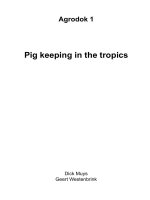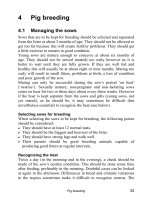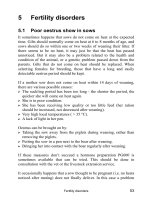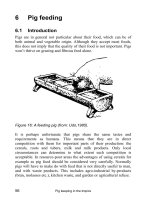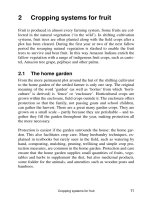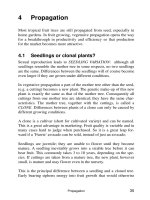Pig keeping in the tropics - part 4 docx
Bạn đang xem bản rút gọn của tài liệu. Xem và tải ngay bản đầy đủ của tài liệu tại đây (121.52 KB, 3 trang )
Fertility disorders 53
5 Fertility disorders
5.1 Poor oestrus show in sows
It sometimes happens that sows do not come on heat at the expected
time. Gilts should normally come on heat at 6 to 8 months of age, and
sows should do so within one or two weeks of weaning their litter. If
there seems to be no heat, it may just be that the heat has passed
unnoticed. But it may also be a problem related to the health and
condition of the animal, or a genetic problem passed down from the
parents. Gilts that do not come on heat should be replaced. When
selecting females for breeding, those that have a long and easily
detectable oestrus period should be kept.
If a mother sow does not come on heat within 14 days of weaning,
there are various possible causes:
? The suckling period has been too long - the shorter the period, the
quicker she will come on heat again.
? She is in poor condition.
? She has been receiving low quality or too little feed (her ration
should be increased, not decreased after weaning).
? Very high local temperatures ( > 35 °C).
? A lack of light in her pen.
Oestrus can be brought on by:
? Taking the sow away from the piglets during weaning, rather than
removing the piglets.
? Putting the sow in a pen next to the boar after weaning.
? Bringing her into contact with the boar regularly after weaning.
If these measures don’t succeed a hormone preparation PG600 is
sometimes available that can be tried. This should be done in
consultation with the vet or the livestock extension service.
It occasionally happens that a sow thought to be pregnant (i.e. no heats
noticed after mating) does not finally deliver. In this case a problem
Pig keeping in the tropics 54
may have occurred after mating, resulting in her infertility or a
miscarriage. This sow should be culled.
5.2 Diseases leading to fertility disorders
Brucellosis and leptospirosis (described below) can both result in the
sow miscarrying. Miscarriage (or abortion) is a termination of the
pregnancy before its proper term, with the foetus and the placenta
being rejected. Some sows eat this up very quickly with the result that
the abortion occurs without being noticed.
The diseases are not the only causes of miscarriage. Sometimes
completely healthy animals will abort for inexplicable reasons. This
occurs very rarely however with relatively few cases reported every
year. More alarming is the occurrence at the same time of several
cases on a single farm. This would indicate a disease-related problem
which could spread rapidly amongst the animals and to other farms.
If several miscarriages occur together the cause may be one of the
diseases mentioned here, or swine fever or swine erysipelas which are
covered in paragraph 7.5 below. As soon as possible the vet or the
livestock authorities should be warned.
? Contagious abortion (Brucellosis)
Brucellosis in pigs is not caused in the same way as in cows, sheep
and goats. An outbreak can result in sudden abortion by pregnant
sows, followed by temporary or permanent infertility. The sows
may abort at any stage in their pregnancy. Some animals may
become crippled (inflammation of the joints) and boars may
develop an inflammation of the scrotum, with swelling and pain.
There is no treatment for this. The disease may disappear after a
while, but it often reappears. In most cases the whole herd will have
to be slaughtered (and this is required by law in some countries).
The entire holding should be cleaned and disinfected. For at least
two months no pigs should be allowed on the site. New animals
should be blood-tested by the veterinary service.
Fertility disorders 55
Prevention: an infected animal brought in from outside (such as a
boar) is usually the cause (the disease can be transmitted by
mating). If the sow is mated off the farm she may return with the
disease. One should be very cautious when bringing outside animals
onto the site. The disease can also be transmitted to humans!
? Weil’s Disease (Leptospirosis)
This disease is marked by sudden abortion by a number of sows,
usually towards the end of their pregnancy. The piglets are often
different in size, as they have died in the womb at various stages of
the pregnancy. Sometimes very weak piglets are born at the normal
time. After the abortion there is no loss of fertility in the sows and
the disease dies out on its own accord within a few months.
During a leptospirosis epidemic abortions can be prevented if all the
pregnant sows are given two injections of dihydrostreptomycine in
doses of 25 mg per kg. body weight, with an interval of one week in
between each injection.
? Smedi virus
Infection by the Smedi virus (PARVO) is very similar to infection
by Weil’s disease. Recently bought gilts in particular (who have not
developed any resistance to the viruses present on the holding) may
deliver a number of still-born piglets. These are often full-term or
even overdue, but they will have died at different stages of the
pregnancy, and will therefore vary in size. Once exposed to the
disease the animals develop a resistance to it and future breeding
can take place normally (such gilts should not be culled!).

